Take care of your health
GYNECOLOGICAL
EXAMINATIONS
Gynecological examinations are essential for the prevention and early detection of conditions such as cervical cancer and ovarian cysts. Regular consultations help maintain intimate health and increase the chances of effective treatment. At Aurora Medical, we offer a full range of gynecological services, from routine check-ups to specialized diagnostic procedures.
Schedule a gynecological examination in Warsaw⬇️
Gynecological Care at Aurora Medical: Comprehensive Women’s Health Services
Gynecological examinations are an essential part of every visit to a gynecologist. Basic gynecological tests are crucial for prevention and diagnosis, enabling the early detection of conditions such as cervical cancer or ovarian cysts. Regular consultations help maintain intimate health, allow for early detection of diseases, and support the prevention of reproductive health issues. Every woman should undergo regular gynecological examinations for preventive care and early disease detection, which increases the chances of identifying changes at an early stage and ensures more effective treatment. At Aurora Medical, we offer a full range of gynecological services, from routine check-ups to specialized diagnostic procedures.
What Does a Gynecologist Do?
A gynecologist is a physician specializing in women’s intimate health across different stages of life, particularly during the reproductive years. The main responsibilities of a gynecologist include:
Prevention and treatment of diseases of the reproductive organs
Diagnosis of fertility-related issues
Management of pregnancy and postpartum care
It is important to note that a pediatric gynecologist plays a key role in caring for younger patients, especially during puberty. The first visit to a pediatric gynecologist is recommended if there are concerning symptoms, menstrual problems, or before becoming sexually active. For girls who have become sexually active, the first visit should occur after sexual initiation or no later than three years after, which is important for proper diagnostics and preventive healthcare.

During an initial visit to a pediatric gynecologist, special procedures are used, tailored to the patient’s age and developmental stage. Examination of virgins differs from a standard gynecological exam—it is often limited to an external examination and transabdominal ultrasound, with diagnostic methods chosen to ensure maximum comfort and safety for the young patient.
Gynecology and obstetrics specialization lasts five years and includes both medical knowledge and practical training in managing deliveries and diagnosing gynecological diseases.
Gynecological Examination – What It Is and How It Proceeds
A gynecological exam allows assessment of the reproductive organs and early detection of abnormalities. It consists of two stages: a subjective examination (medical history) and an objective examination (physical assessment). The medical history is particularly important, during which the doctor collects information about the patient’s health, symptoms, and past illnesses.
During the visit, the doctor explains what the gynecological exam involves, including evaluation of pelvic organs such as the uterus, fallopian tubes, and ovaries, often using ultrasound. The exam itself is quick, non-invasive, and safe. Visits take place in a friendly environment, and the doctor explains each step, which helps reduce stress and increase the patient’s comfort. During the medical history, patients should report any concerning symptoms, their severity, and duration so that the doctor can make an accurate diagnosis and recommend appropriate treatment.
Subjective Examination (Medical History)
During the medical history, the doctor asks about:
Age – bleeding during reproductive years may indicate menstrual disorders, while in menopause it requires cancer diagnostics
Occupation – stress and exposure to harmful factors may affect the cycle and reproductive health
Family history – assessment of the risk of hereditary diseases, such as diabetes, hypertension, reproductive system cancers, and genetic predispositions, particularly regarding breast cancer risk
Menstrual history – date of last period, first menstruation, duration and flow, and any irregularities
Obstetric history – previous pregnancies, miscarriages, ectopic pregnancies, course of deliveries, condition of newborns
Past illnesses and surgeries – information on previous diseases and surgeries, important for further diagnostics
Pain symptoms – questions about pain that may indicate reproductive organ disorders; patients should also report other concerning symptoms such as discharge, pain, or skin changes
Religious beliefs – relevant for planned surgical procedures or potential need for blood transfusion
Objective Examination
Includes evaluation of the patient’s general condition, examination of the breasts, and external and internal reproductive organs. The goal of the exam is:
Assessment of the pelvic organs
Detection of inflammation, uterine fibroids, or early-stage tumors
Diagnostics for symptoms such as lower abdominal pain, abnormal bleeding, or discharge
Screening allows for early detection of pathological changes and potential abnormalities in the reproductive organs, including the genital tract.
During the reproductive organ exam, the doctor performs a bimanual examination, assessing uterine mobility and the condition of the vaginal walls. This helps detect uterine fibroids, developmental anomalies, anatomical defects, and polycystic ovary syndrome (PCOS).
Additionally, the doctor often performs transvaginal ultrasound (or transabdominal ultrasound for sexually inactive women) and collects a cervical smear for cytology. Early detection of pathological changes significantly increases the chances of successful treatment.
How to Prepare for a Gynecological Exam
A gynecological exam does not require extensive preparation, but it is important to follow a few guidelines:
Maintain basic intimate hygiene – wash the genital area daily, use gentle, dedicated intimate hygiene products, and avoid inappropriate personal care products.
Do not perform vaginal douching before the exam, as it can disturb the natural bacterial flora and affect diagnostic results.
Empty your bladder and bowels to make the examination more comfortable.
Abstain from sexual intercourse, using tampons, or vaginal suppositories, and discontinue vaginal medications approximately 48 hours before a Pap smear, as these can affect the accuracy of test results.
It is best to schedule the visit a few days after the end of menstruation, although this is not mandatory—most tests can also be performed during bleeding if alarming symptoms occur.

Types of Gynecological Examinations
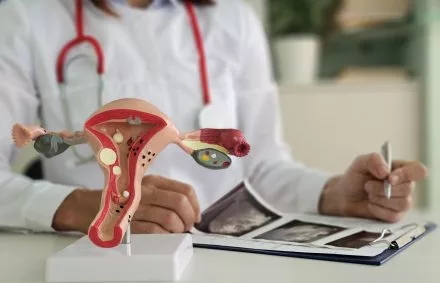
Ultrasound Examination of the Reproductive Organs
Gynecological ultrasound is a basic imaging test for diagnosing reproductive organs. It can be performed as transvaginal ultrasound, through the abdominal wall, or in special cases, through the rectum. Transvaginal ultrasound is highly precise and is especially recommended for non-pregnant women and those who are overweight, as it allows for an accurate assessment of the uterus, ovaries, and fallopian tubes.
The examination allows for the assessment of the uterus, ovaries, fallopian tubes, the number and size of ovarian follicles, endometrial thickness, detection of cysts, ovarian tumors, and endometrial hyperplasia. During pregnancy, genetic ultrasound is also performed to rule out fetal developmental abnormalities.
Breast Ultrasound Examination:
This is a non-invasive test that evaluates the mammary glands, mainly in young women or when palpable changes such as lumps or thickening are detected. It allows visualization of the glandular and fatty tissue structure, and the detection of cysts, tumors, or implant changes.
The procedure is quick and requires no preparation – the patient lies down, the breasts are covered with gel, and the ultrasound probe is moved over the entire surface of the breasts and the armpit area. The examination usually takes 10–20 minutes.
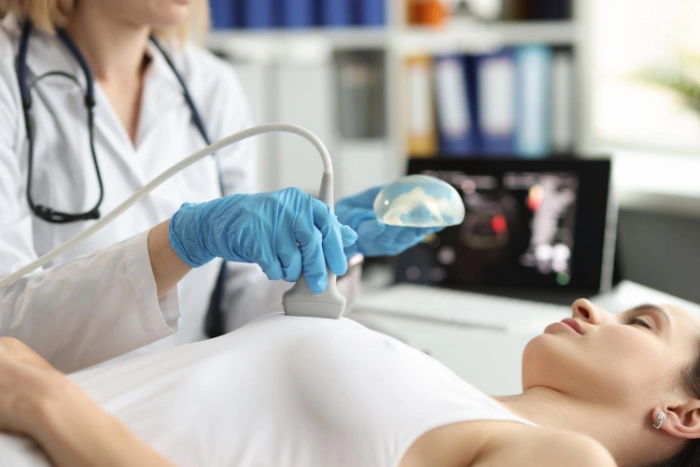
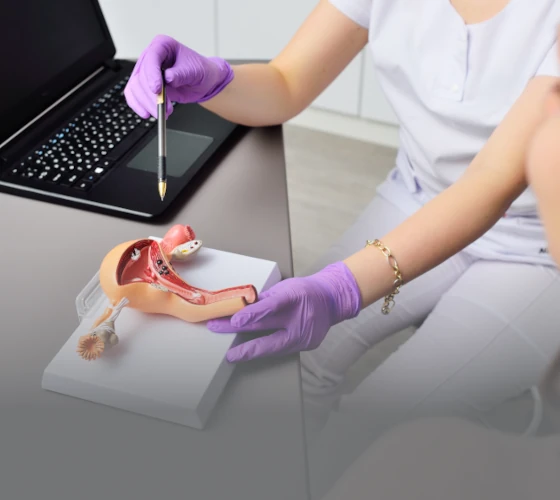
Cytological Examination (Pap Smear):
Collection of cells from the cervix for microscopic evaluation, allowing the detection of abnormal cells.
Early detection of cancerous changes, inflammations, or other abnormalities.
Recommended regularly every 3 years, or more frequently in cases of increased risk.
Regular cytological testing plays a key role in the prevention of cervical cancer.
Colposcopy
Examination of the epithelium of the cervix, vagina, and vulva using a colposcope.
Collection of samples for cytological and bacteriological tests.
Particularly useful for detecting HPV infections.
Hysteroscopy and Hysterosalpingography (HSG)
Hysteroscopy: Insertion of a camera into the uterus to evaluate the uterine walls, often with a biopsy for histopathological examination; allows a detailed assessment of the uterine cavity.
HSG: Injection of contrast and X-ray imaging to assess the patency of the fallopian tubes.
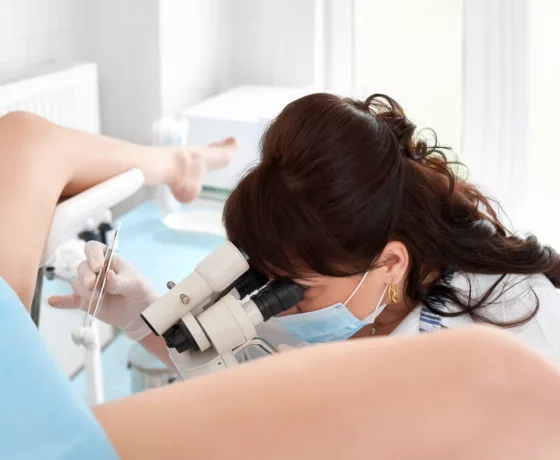
Gynecological laparoscopy is another diagnostic and therapeutic method used in gynecology. It allows for the assessment of reproductive organs, removal of lesions and cysts, and treatment of infertility. The procedure is minimally invasive, which contributes to a faster recovery and lower risk of complications. Both hysteroscopy and gynecological laparoscopy are performed under general anesthesia, ensuring comfort and safety for the patient during the procedures.
These examinations are used in the diagnosis of infertility causes, such as adhesions, polyps, or structural abnormalities of the reproductive organs.
Step-by-Step Gynecological Examination
A gynecological exam is performed both during routine check-ups and when symptoms are present. Routine visits aim to assess a woman’s overall health, evaluate reproductive organs, and provide preventive care or continue ongoing therapy.
Medical History and General Examination:
Assessment of height, weight, blood pressure, and medical history.
Conducted on a gynecological chair to ensure comfort and professionalism.
Breast Examination:
Evaluation of the mammary glands and axillary lymph nodes.
Education on breast self-examination.
Examination of the Reproductive Organs:
Inspection of the external genitalia.
Vaginal speculum examination and collection of samples; some discomfort may occur, which is normal.
Bimanual examination of internal organs.
Transvaginal or transabdominal ultrasound.
Examination via the Rectum and for Virgins:
Used for virgins or in oncological diagnostics to assess the lateral parametrium and the Douglas pouch.
Vaginoscopy or rectal ultrasound may be an alternative for women who are not sexually active.
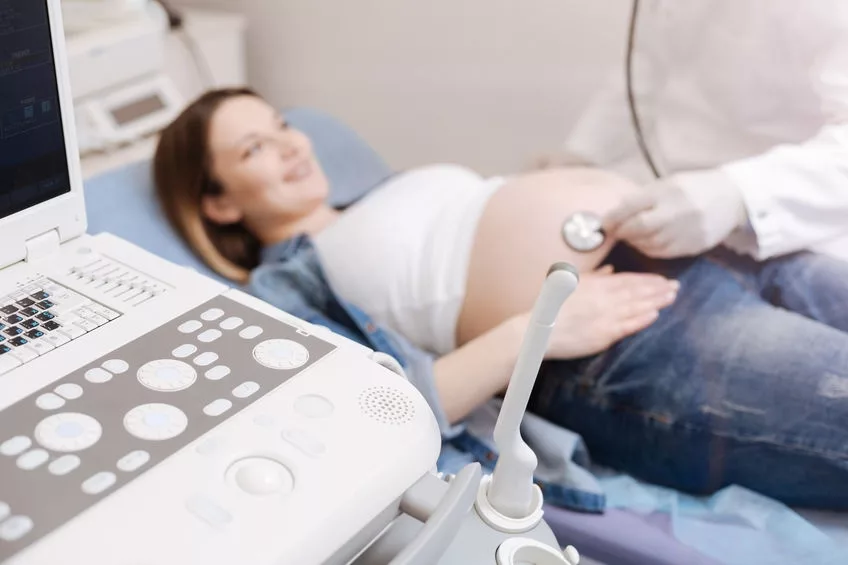
Gynecological Examinations During Pregnancy
First Visit: Up to the 10th week of pregnancy – standard examination, cytology (Pap smear), ultrasound, assessment of vaginal cleanliness, and exclusion of ectopic pregnancy.
Subsequent Examinations: Include regular ultrasound monitoring, genetic testing, evaluation of fetal development, and assessment of the cervix’s readiness for delivery.
If abnormalities are detected, the doctor may refer the patient for further diagnostics to confirm or rule out a diagnosis and plan appropriate management. Once a diagnosis is confirmed, the doctor implements suitable treatment tailored to the patient’s needs to effectively improve her health.
Laboratory and Additional Tests
Blood Tests: Complete blood count, hormone levels, and blood sugar assessment – these evaluate overall health and reproductive function. Laboratory tests, including hormonal assays, are a crucial part of preventive care, allowing early detection of abnormalities such as polycystic ovary syndrome (PCOS).
Imaging Tests: Ultrasound and other imaging techniques, such as CT, MRI, and X-ray, are used in the diagnosis of tumors or organ patency. Imaging tests, especially ultrasound, are also important in diagnosing PCOS and play a key role in preventive screening, particularly for cervical and breast cancer.
Bacteriological Tests: Detection of infections and selection of targeted treatment.
Regular preventive examinations enable early detection of diseases and precancerous changes, which is essential for maintaining women’s health.
Why Regular Gynecological Examinations Are Important
Early Detection of Diseases: Enables the identification of pathological and cancerous changes, including cervical cancer, at an early stage.
Timely Treatment: Regular check-ups allow for the implementation of appropriate treatment if abnormalities are detected.
Diagnosis and Management of Conditions: Helps in the evaluation and treatment of issues such as urinary incontinence.
Improved Fertility Care: Supports more effective management of fertility problems.
Monitoring Reproductive Health: Ensures proper tracking of the menstrual cycle and overall reproductive well-being.
Peace of Mind and Safety: Regular specialist consultations provide reassurance and security.
Summary
Regular gynecological examinations at Aurora Medical are key to maintaining both reproductive and overall health. We offer a comprehensive range of diagnostics – from routine visits to specialized procedures such as biopsies and colposcopy. With professional medical care and modern equipment, patients can feel safe and comfortable.
Don’t wait for symptoms – take care of your health and schedule a visit at Aurora Medical today!
Frequently Asked Questions (FAQ)
– The exam includes a medical interview, assessment of external and internal genital organs, breast examination, vaginal speculum examination, sample collection for tests, and often a transvaginal ultrasound.
– The exam is usually painless, though some women may feel slight discomfort during the speculum or bimanual examination.
– The doctor may examine the external genital organs, including the Bartholin glands and clitoral area, but always respecting the patient’s comfort.
– No, intimate hygiene is more important. Shaving is not required.
– Results of previous tests, medical documentation, a list of medications, and any questions about intimate health.
– No, the exam assesses the condition of the organs, not the patient’s sexual activity.
– Yes, alternative methods are used, such as a rectal exam or vaginoscopy.
– Intensive washing or using vaginal cosmetics,
– Using tampons or vaginal suppositories 48 hours before a Pap smear,
– Postponing the visit if you have concerning symptoms such as bleeding or lower abdominal pain.